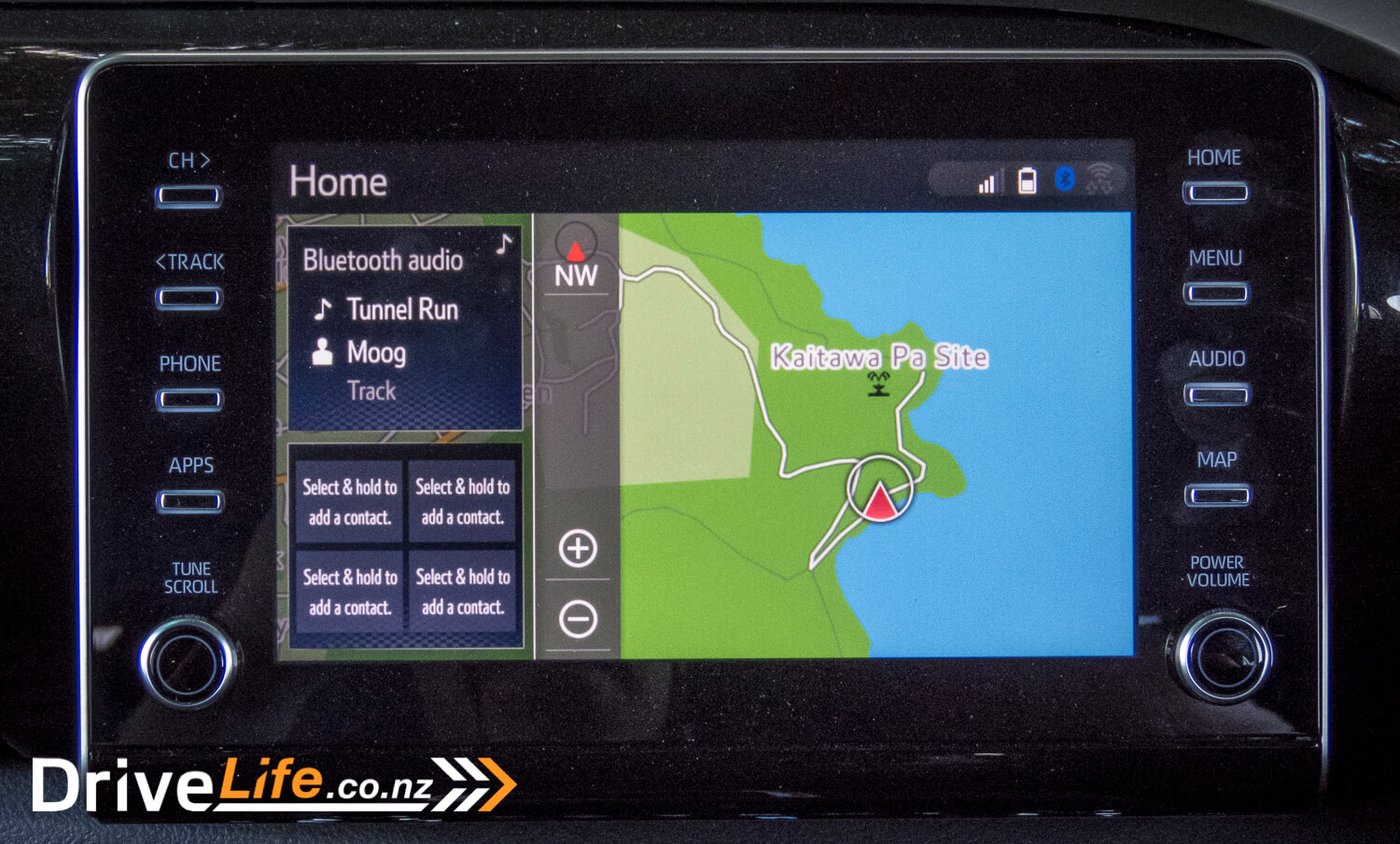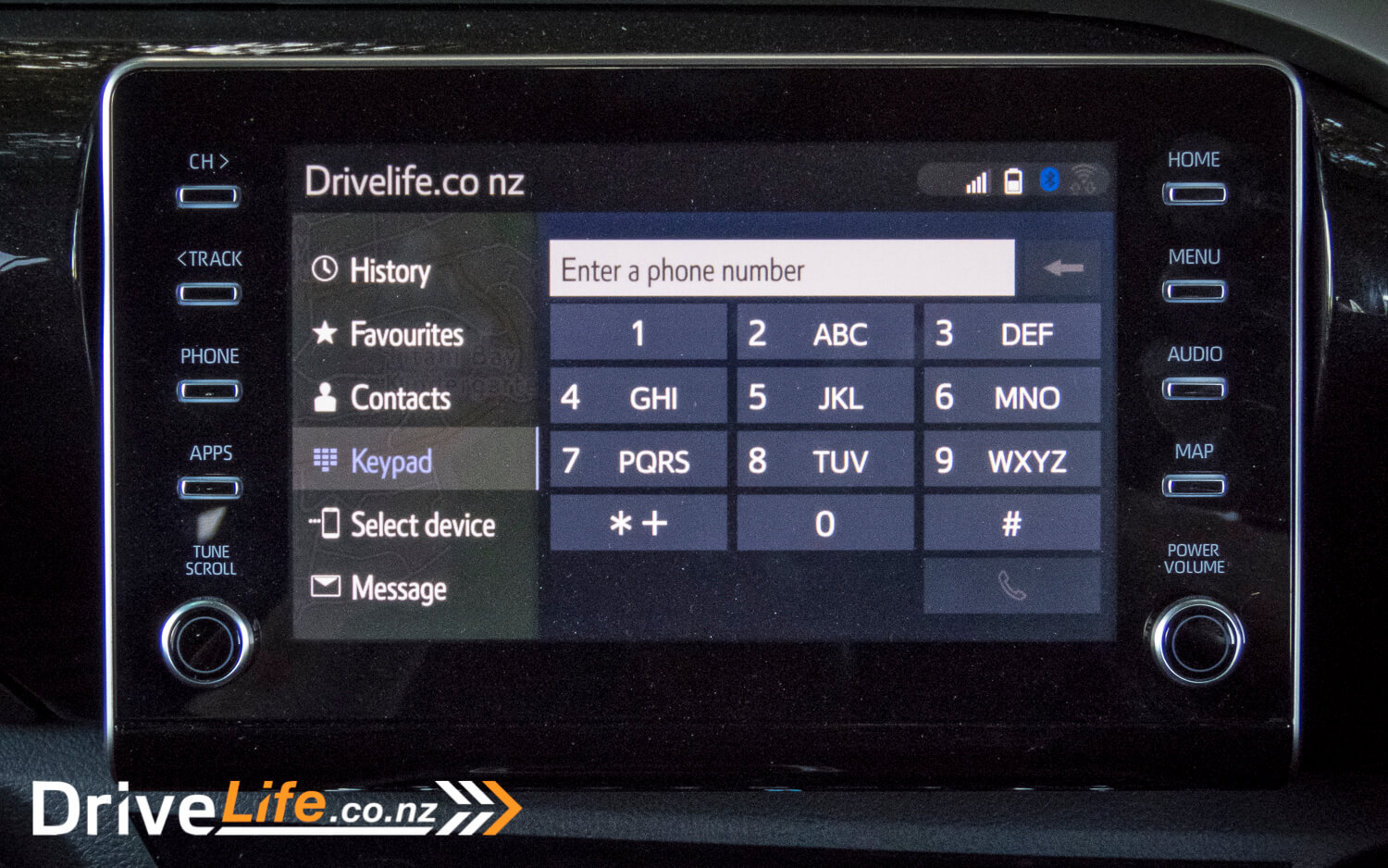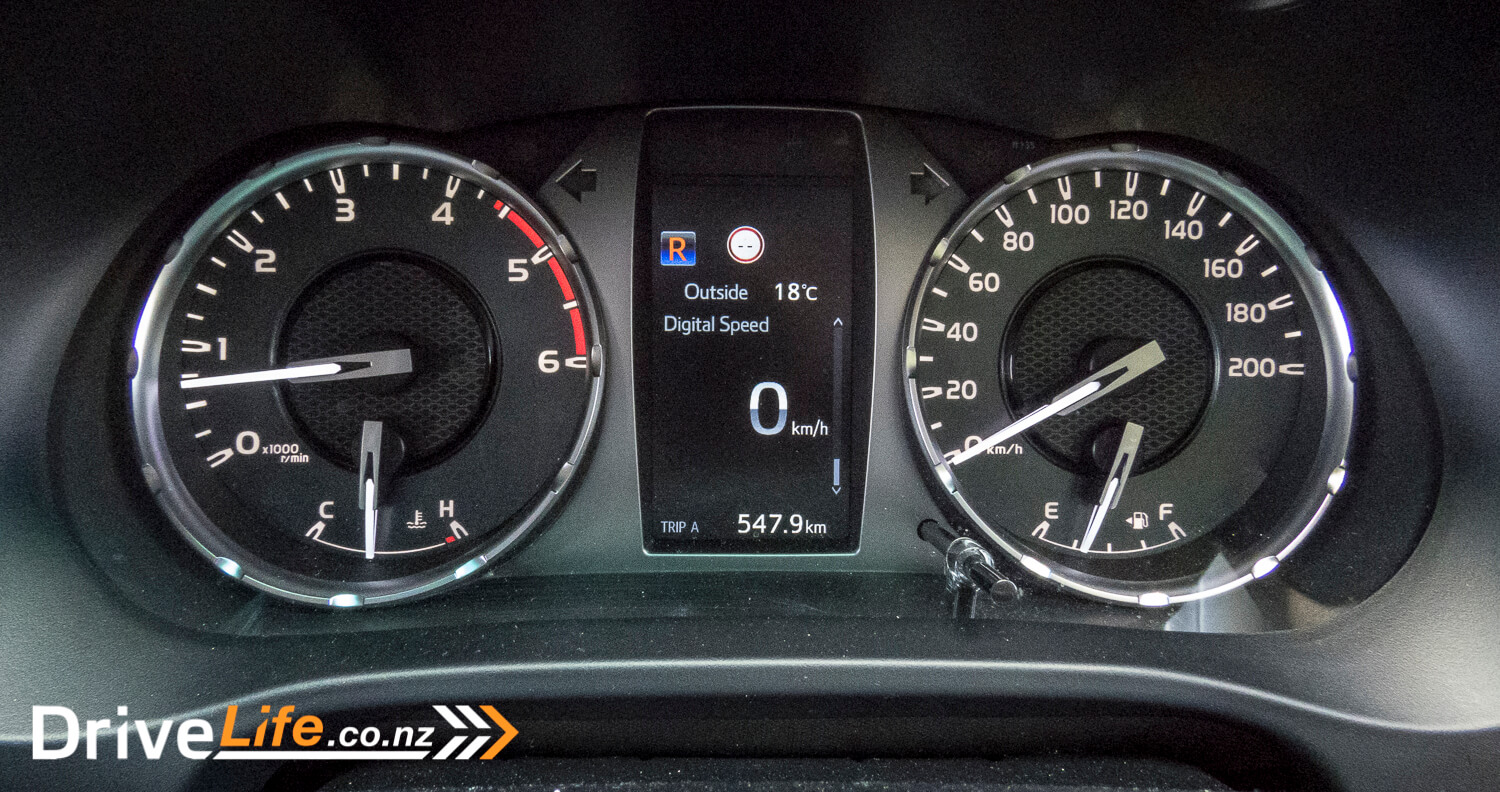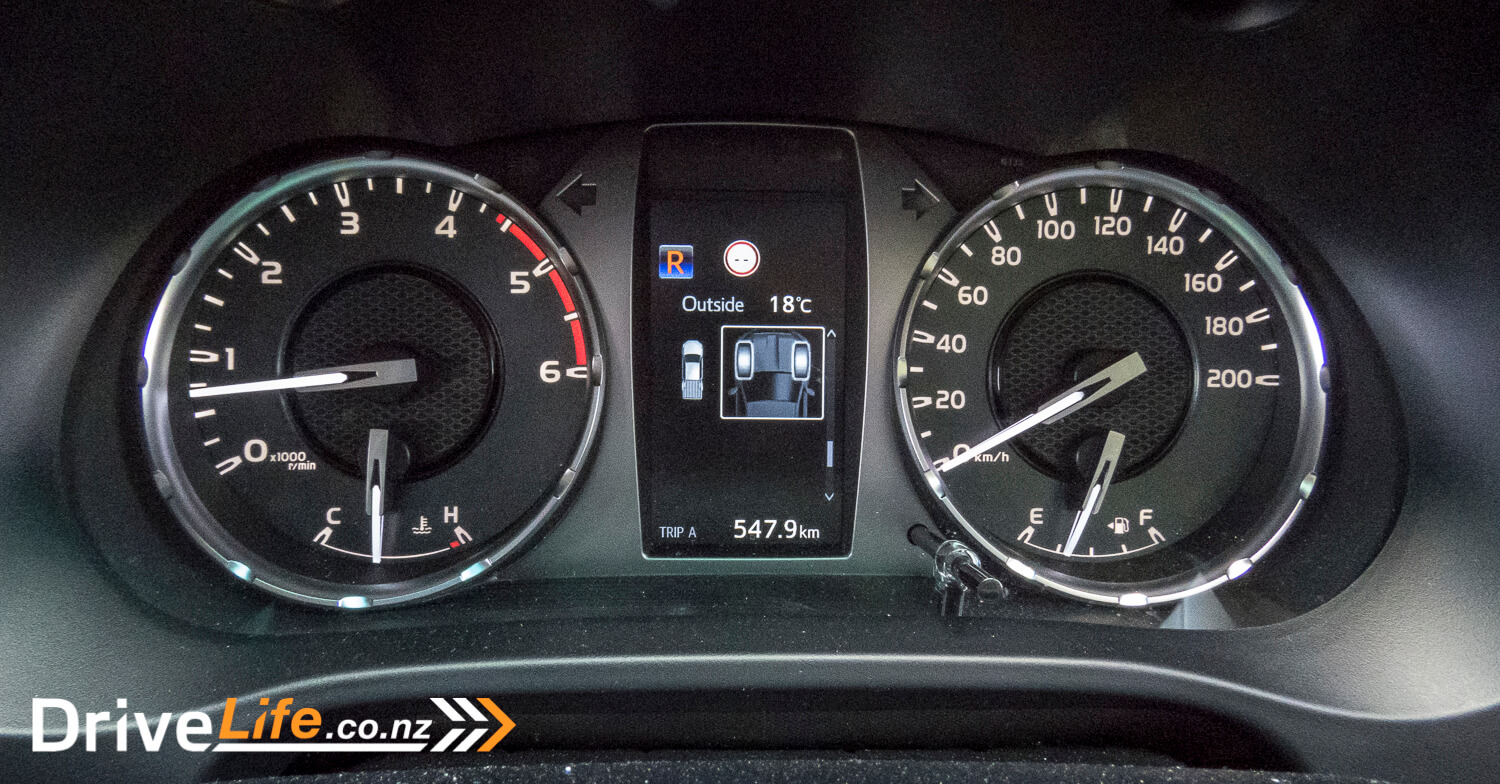The ute is a common sight on New Zealand roads. Of all the utes out there, few are better known than the Toyota Hilux. Whether it’s the memorable advertisements, demonstrations of its capability or if you watched Top Gear’s attempts to obliterate one, the Hilux enjoys household name status within New Zealand.
Its capable and indestructible reputation has served Toyota well, with over 142,000 Hilux’s having been sold in New Zealand.
Advance ahead to 2021, the Hilux remains popular to this day. Although the ute market has grown, and in sales terms, the Hilux shares the podium with some strong competition, namely the Ford Ranger. So naturally when Toyota announces a new Hilux, we know this going to be a big deal for the ute market.
Last year, we attended the launch event of the new Hilux, where Toyota impressed us with a 2-day experience with the new Hilux range. In December, Toyota offered us the keys for a full test. Let’s determine whether the new Hilux can reclaim the podium.
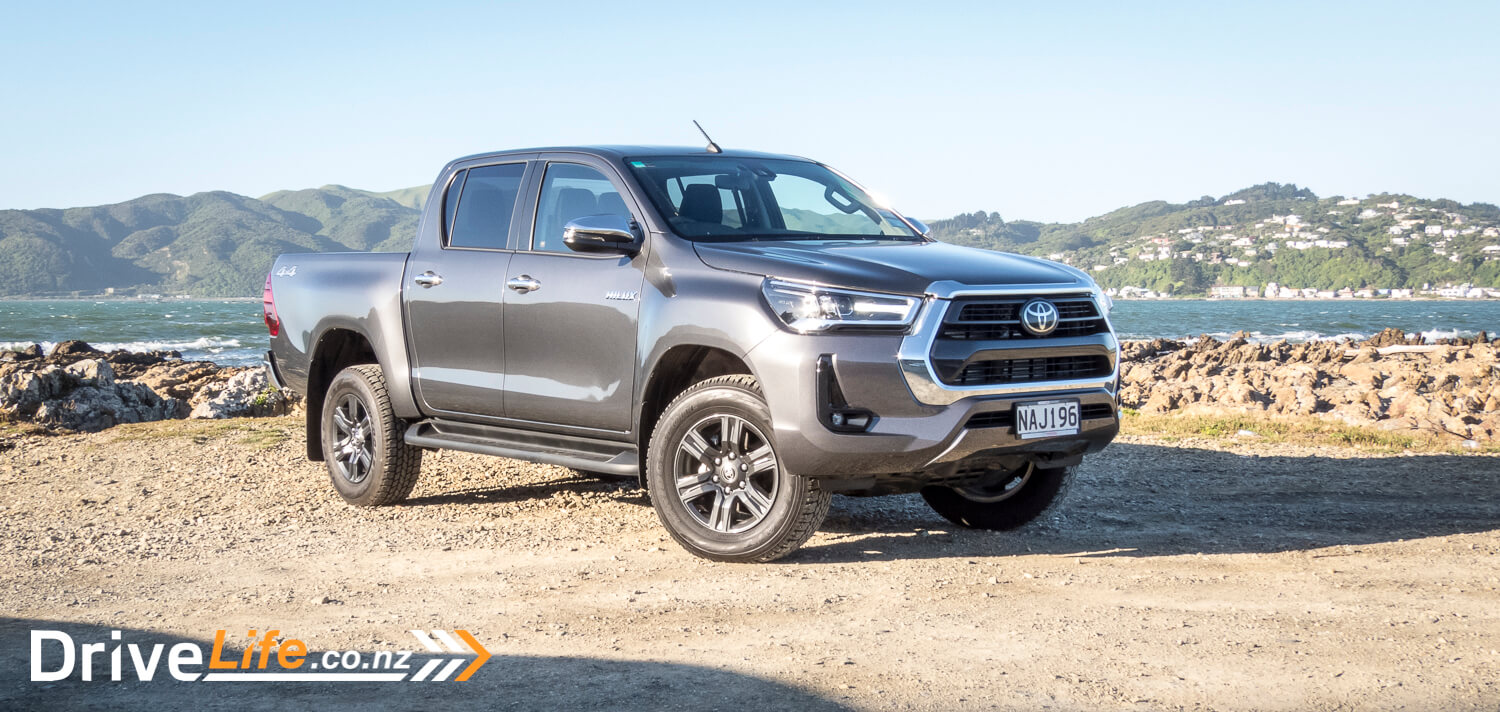
What’s in The 2021 Toyota Hilux Range?
The evidence of the ute’s proliferation is shown within the 2021 Hilux range. There are 18 models of Hilux available in the standard line-up!
The range starts with the entry-level, petrol-powered Hilux workmate starting at $28,990. This climbs up to the range-topping diesel-powered SR5 Cruiser, from $58,990. The range stretches out to 19 models with the inclusion of the Kiwi-modified, Ranger-Raptor scrapping Hilux Mako, which will set you back a whopping $79,990.
Although there’s plenty to take in, the Hilux range can be distilled down to a handful of core trims once you’ve eliminated the choice of 2WD or 4WD, body style and transmission. Doing this, you’re left with the core trims of the WorkMate, SR, SR5 and SR5 Cruiser.
To avoid going into an unnecessary amount detail on each model, here’s a table to keep it simple;
| 2WD | ||||
| Engine | Model | Body | Transmission | Price |
| 2.7L Petrol | WorkMate | Single Cab | Automatic | $28,990 |
| 2.7L Petrol | WorkMate | Double Cab | Automatic | $29,990 |
| 2.8L Diesel | PreRunner SR | Extra Cab | Automatic | $39,990 |
| 2.8L Diesel | PreRunner SR | Double Cab | Manual | $39,990 |
| 2.8L Diesel | PreRunner SR | Double Cab | Automatic | $41,490 |
| 2.8L Diesel | PreRunner SR5 | Double Cab | Manual | $40,990 |
| 2.8L Diesel | PreRunner SR5 | Double Cab | Automatic | $44,490 |
| 2.8L Diesel | PreRunner SR5 Cruiser | Double Cab | Automatic | $47,990 |
| 4WD | ||||
| Engine | Model | Body | Transmission | Price |
| 2.8L Diesel | SR | Single Cab | Automatic | $44,990 |
| 2.8L Diesel | SR | Extra Cab | Manual | $44,990 |
| 2.8L Diesel | SR | Extra Cab | Automatic | $46,990 |
| 2.8L Diesel | SR | Double Cab (w/o tray) | Manual | $45,990* |
| 2.8L Diesel | SR | Double Cab (w/o tray) | Automatic | $48,490* |
| 2.8L Diesel | SR | Double Cab | Manual | $47,990 |
| 2.8L Diesel | SR | Double Cab | Automatic | $49,990 |
| 2.8L Diesel | SR5 | Double Cab | Manual | $51,990 |
| 2.8L Diesel | SR5 | Double Cab | Automatic | $53,990 |
| 2.8L Diesel | SR5 Cruiser | Double Cab | Automatic | $58,990 |
| 2.8L Diesel | Hilux Mako | Double Cab | Automatic | $79,990 |
*Price does not include tray
So where does our test vehicle sit? We’ve got the 4WD SR5 Double Cab with an automatic transmission, which starts at $53,990.
Being near the top of the Hilux range, the 4WD SR5 Double Cab is pitched more towards your weekend-warrior characters, as opposed to the Waikato’s finest cattle hands.
As a result, the SR5 comes has a fairly extensive list of bells and whistles, including 17’’ alloys, 8’’ infotainment with Bluetooth, Apple Carplay and Android Auto, SatNav with SUNA Traffic channel, Smart Key Entry and Push Button Start, Leather Steering Wheel, 1 x 220V power outlet, 2 x 12V power outlets, single-zone climate control, exterior mirror heaters, front and rear parking sensors, LED lights and DRLs, rear privacy glass, plus chrome trimming on the door handles, grille and side mirrors to lift the SR5’s aesthetics.
Our Hilux is powered with Toyota’s 1GD 2.8L turbo-diesel engine, producing 150kW of power and 500Nm of torque, paired with a 6-speed automatic transmission.
This combination allows for a tow rating of 3500kg braked, 750kg unbraked, which is consistent for the entire diesel Hilux range. Tray payload varies model-to-model. For the SR5, tray payload is 950kg, whereas other models can offer up to 1225kg.
It also wouldn’t be a Hilux without a list of off-roading goodies. The new range includes a Rear Differential Lock, Rear Auto Limited Slip Differential, Down-hill Assist Control and an Automatic Disconnecting Front Differential, plus the usual gearing ratios of 2H – 4H and 4L controlled via switch knob.
All Hiluxes are equipped with 7 airbags, plus Toyota’s Safety Sense (TSS) package. This includes Pre-Collision System with Autonomous Emergency Braking, Lane Departure Alert with Yaw Assist and Vehicle Sway Warning, Adaptive Cruise Control and Road Sign Assist. Other safety items include Drive Start Control, Trailer Sway Control, Vehicle Stability Control, Emergency Stop Signal and a Reverse Camera.
There are seven core colours available for the Hilux range. These are Glacier White, Silver Sky, Graphite (Dark Grey), Eclipse (Black), Olympia Red, Nebula Blue and Deep-Sea Blue (Darker Blue). The SR5 and SR5 Cruiser range gain two unique colours, substituting Olympia Red for Emotional Red (a richer Red), plus Inferno Orange.
For more information on the Hilux range, visit the Toyota New Zealand website.
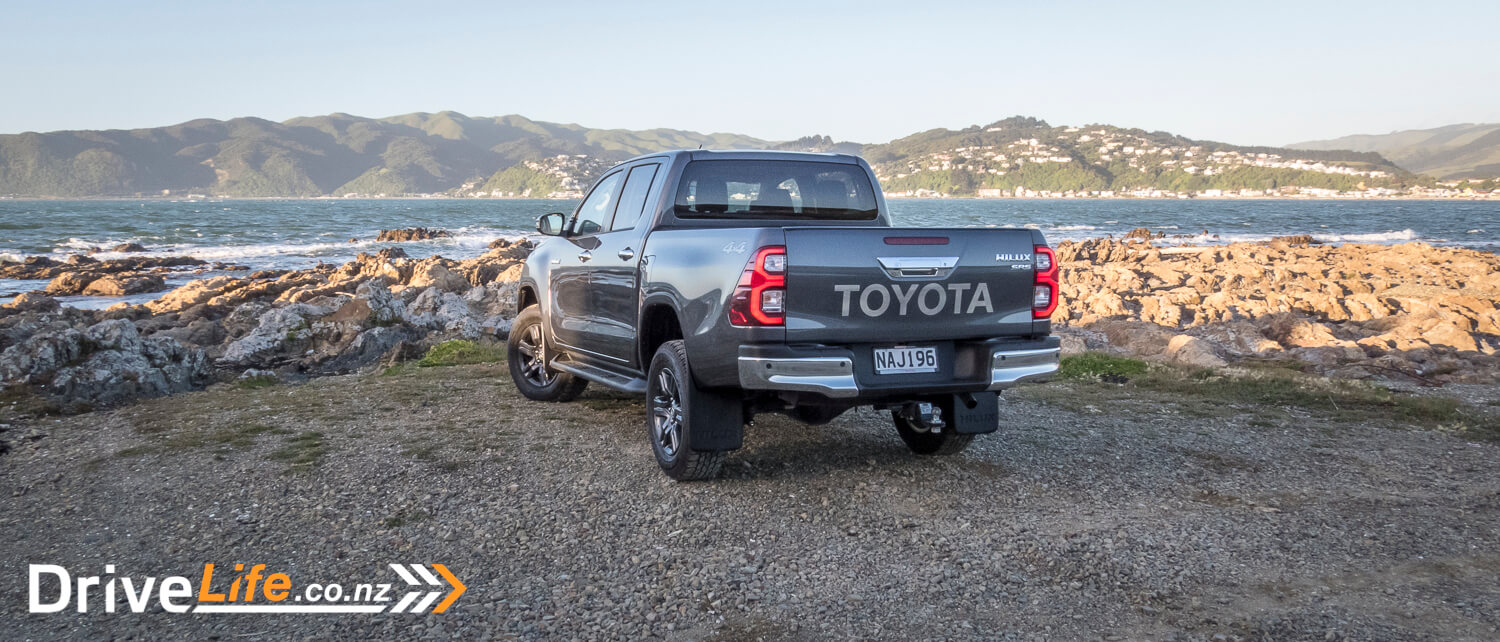
First Impressions Of The 2021 Toyota Hilux SR5
In my opinion, the previous generation Hilux range suffered from an aesthetic hierarchy. Higher spec models were decent looking utes, but you couldn’t say the same for lower spec models. Sure, you could argue this of any vehicle range, but modern Hilux’s were some of the worst offenders.
For me, the 2021 range still hasn’t been able to shake-off this hierarchy. The SR5 Cruiser won the genetics lottery, with its additional trims and fascia’s turning it into a handsome ute. Lower-spec Hiluxes, particularly PreRunners with steel wheels, aren’t so lucky. While on the other end of the spectrum, the Hilux Mako looks like it’d beat you up and take your lunch money.
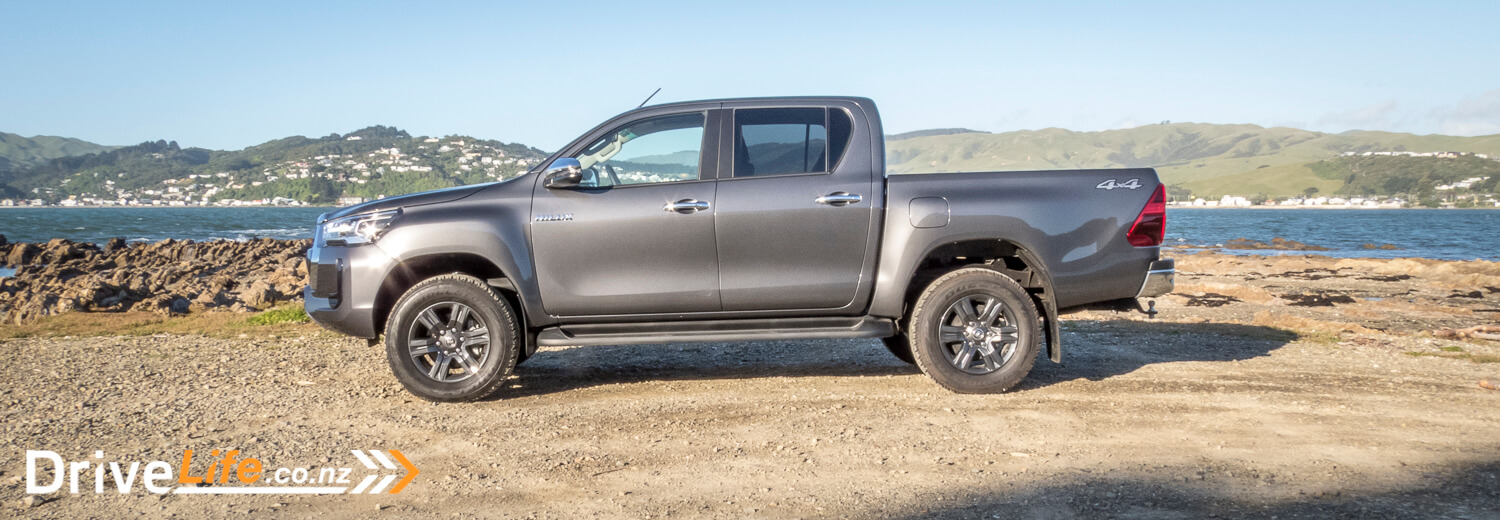
The obvious change for the Hilux is the front-end. The pinched nose of the prior generation is gone, replaced with a wider, more muscular face. Toyota claims that 2021 Hilux’s refreshed look is on-brand with their North American pick-up brothers, such as the Tacoma and the Tundra.
The fresh look means new bumpers, headlights, and a new large trapezoidal grille which gives the Hilux quite a big nose. The SR5’s grille is flanked with some chrome trim which masks its footprint somewhat. I can vote in favour of the new exterior lights, particularly the rear LED lights on the SR5. The fresh alloy design for the SR5 is better too.
Overall, I like the changes for the new model. With all its additional trimmings, the SR5 is one of the better-looking Hiluxes of the range.
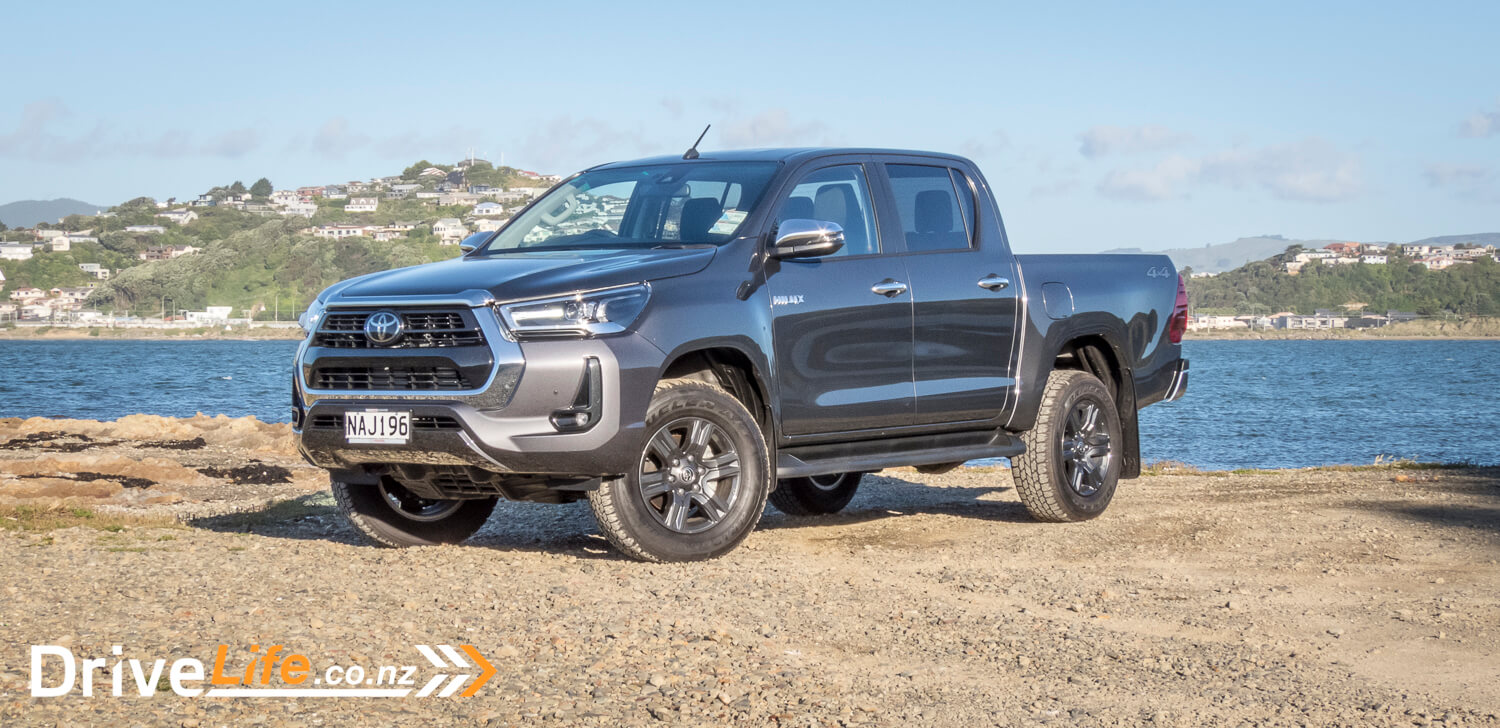
What’s The Interior On A 2021 Toyota Hilux SR5 Like?
‘Utilitarian’ is a word that may spring to mind if this is your first time experiencing a modern Hilux. For those that have experienced the prior generation Hilux, you’ll notice that not a lot has changed.

Key changes for the 2021 model year are a larger infotainment screen, upsized from a previous 6’’ or 7’’ unit in favour of an 8’’ unit across the range. The new unit ditches the CD player, but adds physical buttons for key menus to replace the finicky capacitive-touch buttons on the older system.
The infotainment software is Toyota’s usual offering. It’s decently responsive, but it’s not the crispest user interface available compared with rivals. The package does include Apple CarPlay and Android Auto, which many will default to anyway. For me, my biggest gripe was with the speakers. They’re not the best in the SR5.

There’s also a new dash cluster design with a better LCD display. The screen also gets a handful of extra menus, such as a digital speed and steering angle readouts.
Aside from the tech upgrades, there’s few changes to the overall format. The main dash is made-up of contoured plastics. Silver plastic trims line the air vents and door cards, while gloss black plastic surround the infotainment and switchgear. There’s also some faux-stitching on the upper dash, which you’ll notice is plastic upon closer inspection.
Despite the inside being all hard-plastics, everything felt robust and durable, just as a work ute should. There’s enough storage inside the cabin too. The dash has a nifty dual glovebox set-up. There’s a 240V outlet inside the generously sized centre storage bin, plus there’s some cool pop-out cup holders tucked into the dashboard on each flank of the cabin.
The downside to these hidden cup holders is that they’re on the smaller side. For the tradies out there, they’ll fail the iced coffee test, but will pass with a can of V. Instead, the iced coffee will need to fit in the cupholders in the centre console, assuming the tape measure and pens aren’t in the way.
Another useful feature are the interior hooks. There’s four of them, one on the back of both front seats, plus two above the rear passenger bench seat. These are especially useful, given that your groceries need to go on the back seat in a ute.

The mono-upholstered front seats aren’t particularly inviting from first impressions, but they’re not bad once you’ve saddled yourself into them.
The seats fit wide and have a supportive back, even though the seatback appears thin. The seat base is quite carved out, meaning your thighs run at an upward angle. This usually isn’t the most comfortable design, but I honestly had few complaints doing my daily commute. I’ve also driven a Hilux from New Plymouth to Palmerston North after the launch without any discomfort.
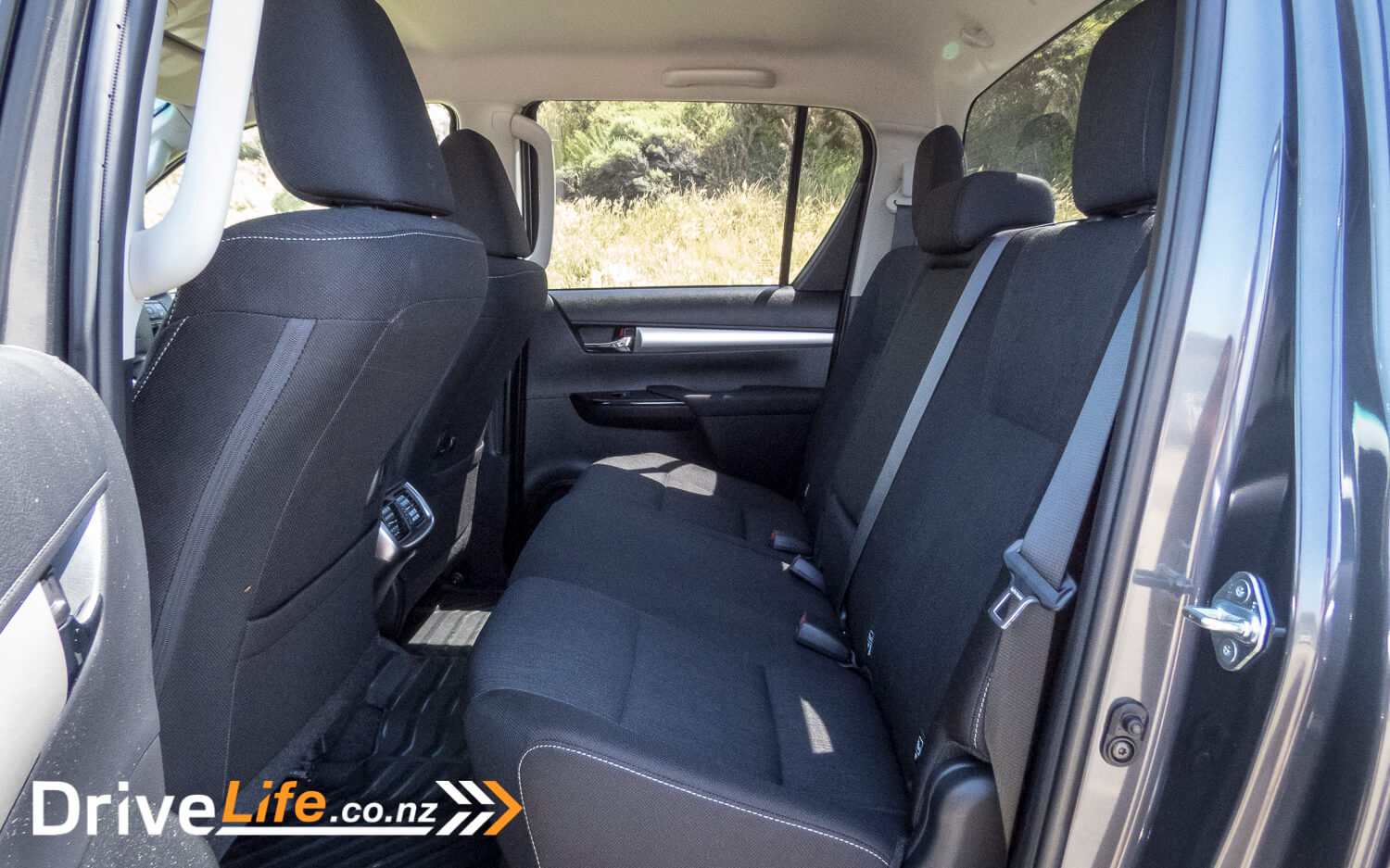
The leather-wrapped steering wheel is the right size and all the buttons are thoughtfully laid out. I’ve always rated Toyota’s classic cruise control stalk, despite having been around for decades. It’s simple, intuitive and declutters the steering wheel.
In true Toyota form, I cannot fault the ergonomics. The driving position was good, and all core controls are logically laid-out. Plus there’s plenty of useful open storage for personal items like wallets and smartphones. The switchboard containing the down-hill assist controls and USB port is a tad obscured from the drivers view, but there’s nothing down there requiring regular interaction.
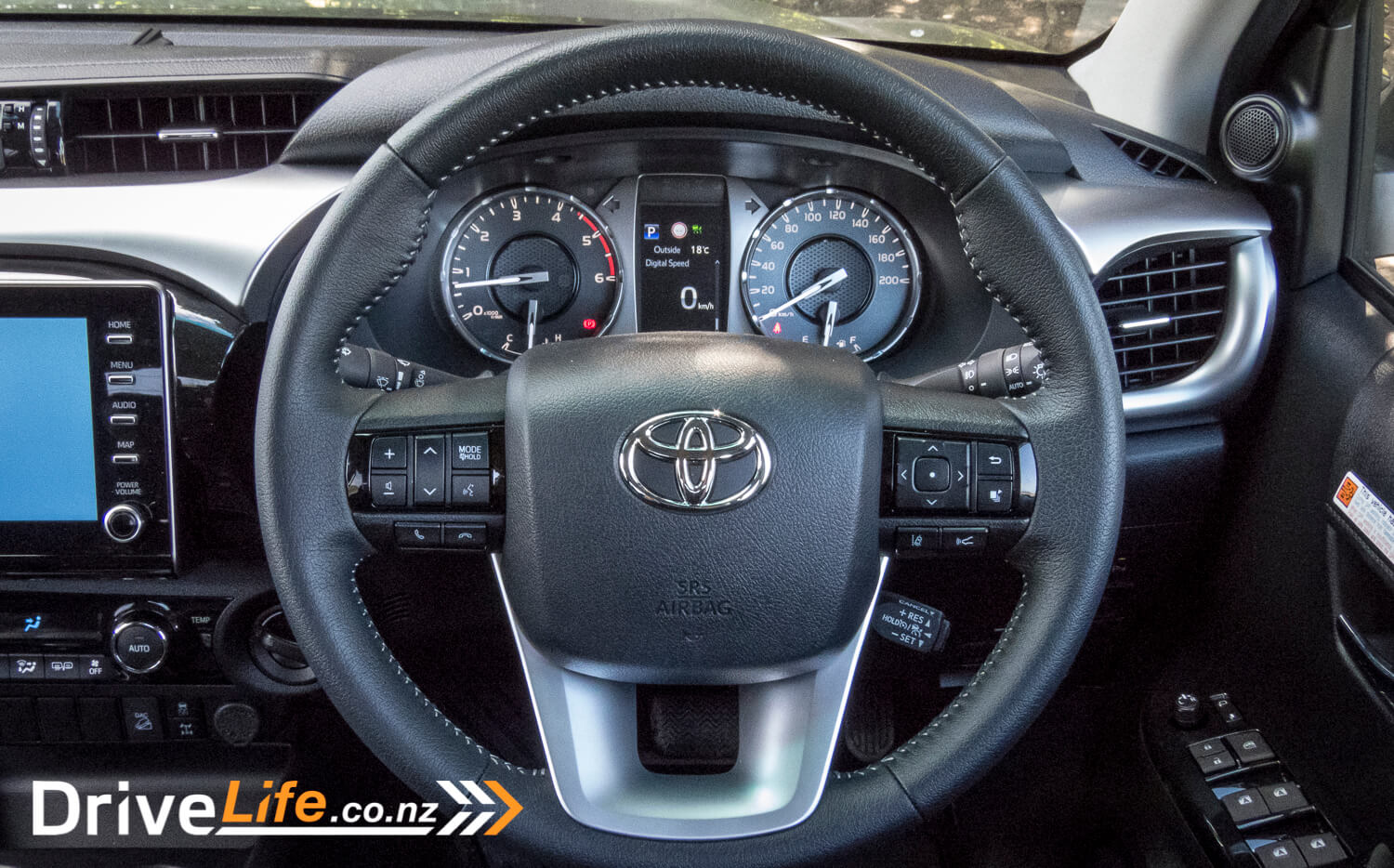
Although everything was pleasant from my perspective, our chief reviewer John (JSG), whose spirit animal is more giraffe than gorilla, took a different perspective in his review of the SR5 Cruiser. The short story is that you may have problems if you’re a taller bloke.
If you’re closer to me in size, which is aptly described as a 5’11, former rugby player (forward pack), who isn’t averse to a pie for lunch, you shouldn’t have an issue.
Overall, the 2021 Hilux interior has had a few touch-ups, but remains largely the same as the prior generation. The design is functional and durable. It’s not quite as pleasant on material and the tech-front compared with some of the competition, but there’s not a lot to fault from my perspective.
I would like better speakers though.
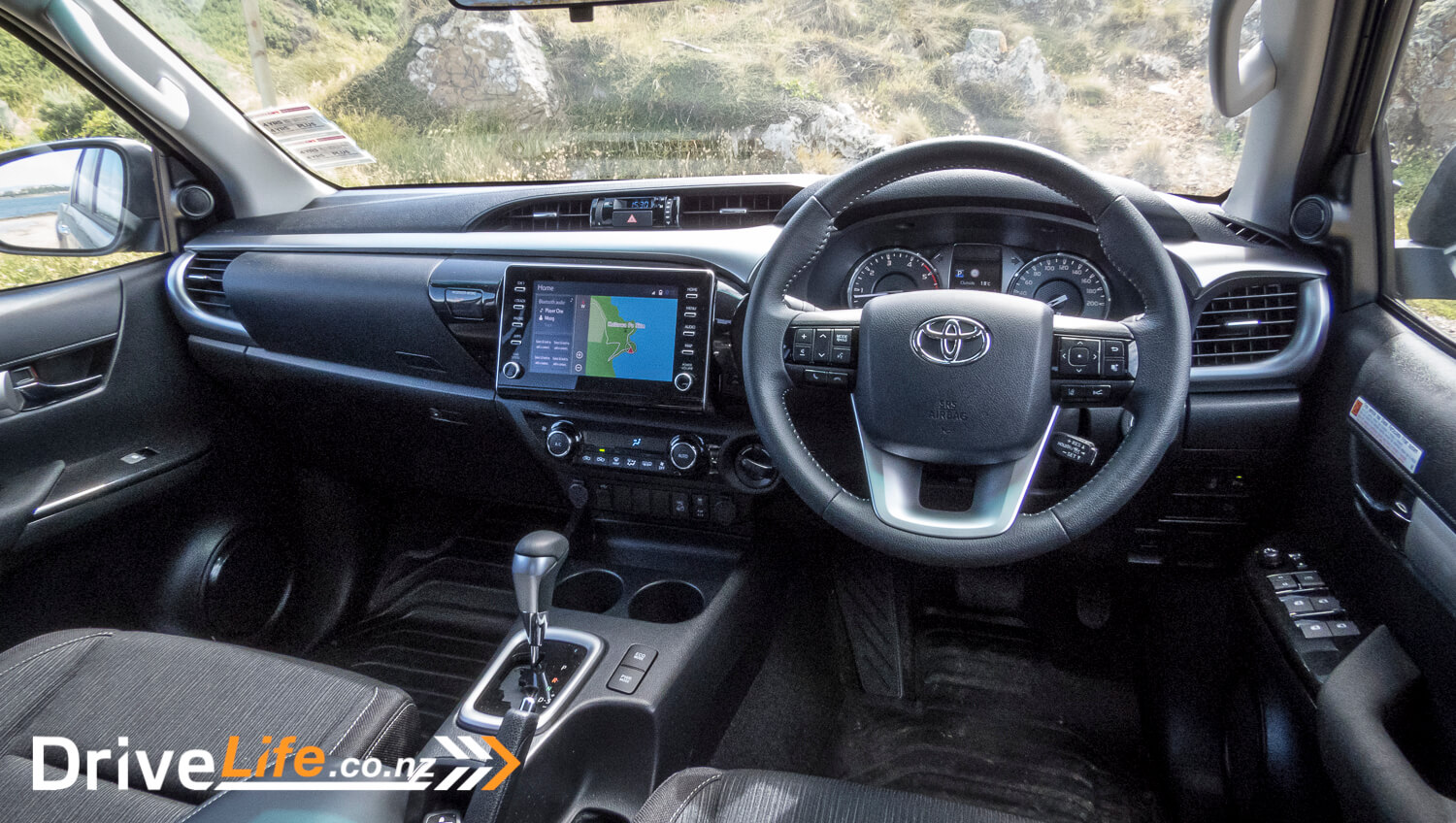
What Does The 2021 Toyota Hilux SR5 Drive Like?
Despite the relatively few changes to the interior, the majority of the improvements made to the new Hilux range are underneath.
Toyota uses a revised version of the 1GD 2.8L 4-cylinder turbodiesel engine from the previous Hilux. On paper, power has increased 15% and torque by 11%, meaning that new diesel Hilux’s produce 150kW of power and 500Nm of torque. The engine is paired with a 6-speed automatic, via 2-wheel and part-time 4-wheel drive.
Although, the term “revised” perhaps doesn’t do the new engine enough justice.
To eke out these performance gains, Toyota redesigned the cylinder block and head-gasket, revised the cooling system, added new pistons plus a new exhaust manifold, and tacked on a slightly larger turbo for good measure.
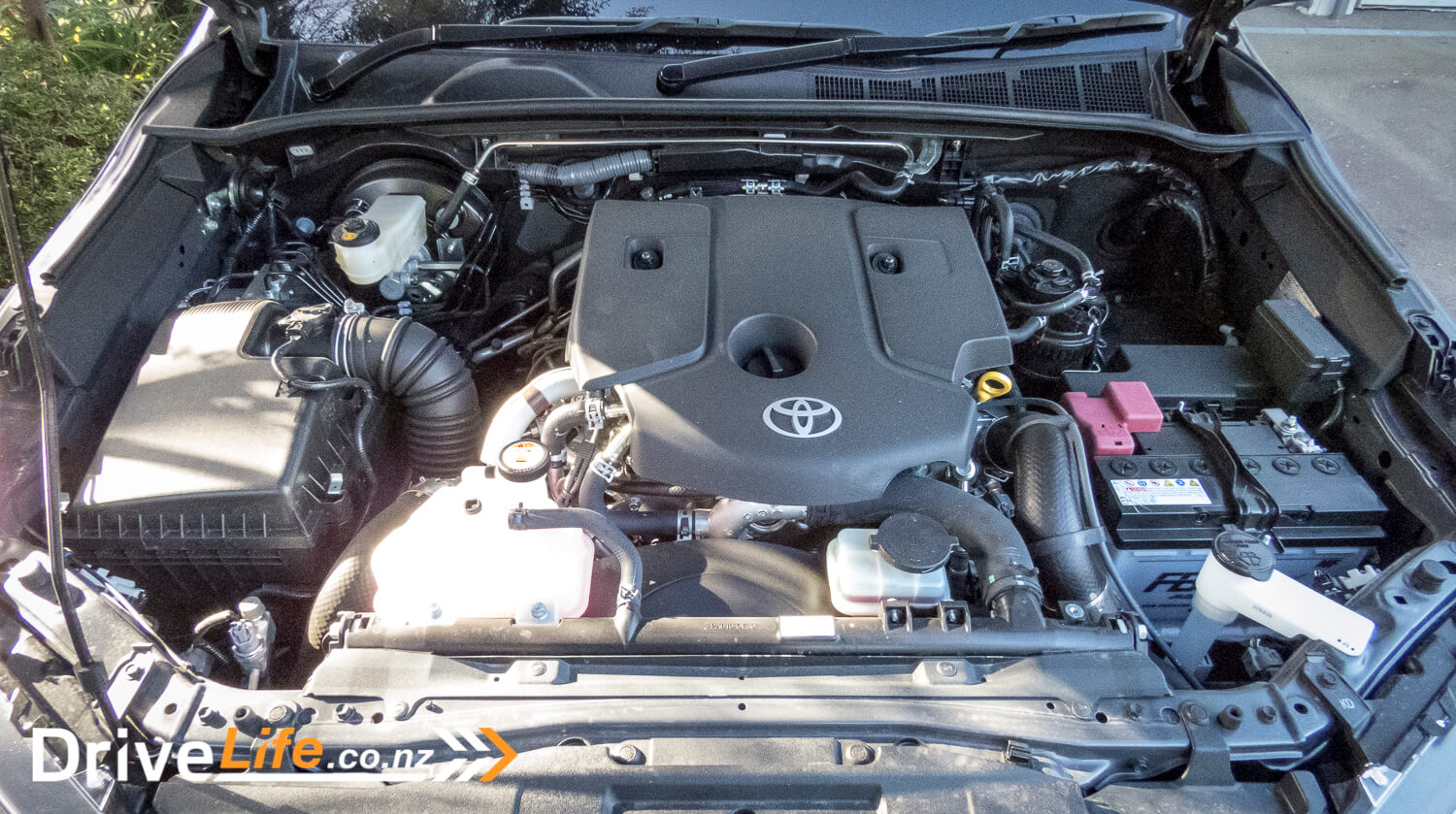
The outcome of all these changes? Toyota’s improvements give the Hilux greater mid-range, or more meat under-the-curve.
Out on the road, it doesn’t take long to realise the Hilux’s modernised diesel is an excellent engine. Power is ample, while torque is available from down low and across a broad rpm range, meaning there’s consistent pull through all gears.
Toyota’s engineers also had their heads screwed on when programming the 6-speed automatic. It’s a solid transmission, handling the increased performance well. To eke out that extra performance, it’ll also hold a gear quite high into the rev-range before shifting.
Translating this into the real world, the new Hilux felt surprisingly brisk. Our SR5 made light work of passing lanes and overtaking manoeuvres. You also never felt the engine exerting itself under load either. Unlike some of the turbo-diesel ute competition where you can hear the turbo sitting mid-spool commuting the motorway, this seldom occurs in the Hilux.
This low-down performance can demonstrate itself time-to-time with a heavy foot. It’s easier than most to make the rear tyres break traction in the Hilux.
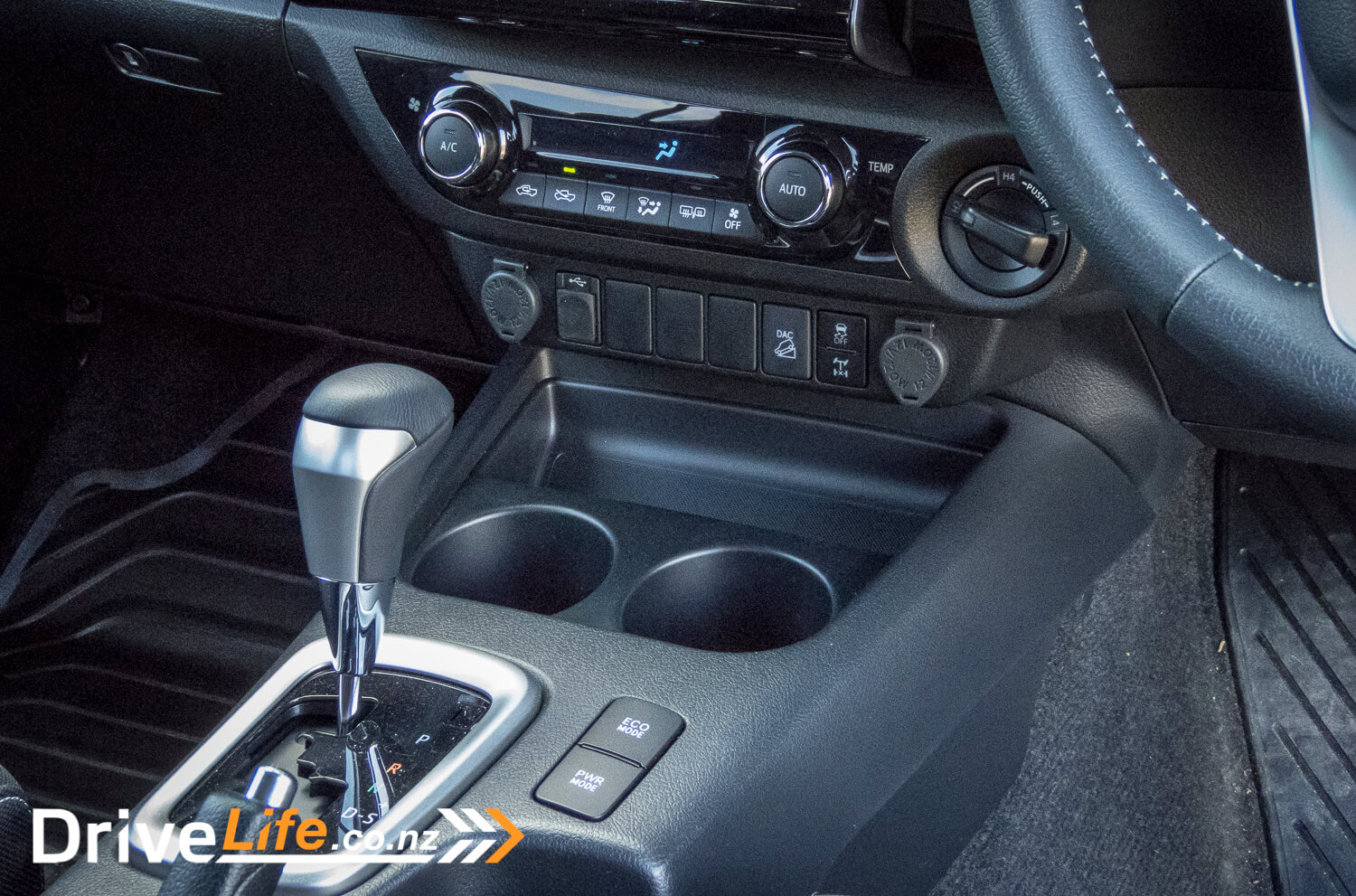
Drive around with a lighter foot, Toyota claims a combined fuel economy of 7.9L/100Kms. During our time with the Hilux, I achieved a fuel economy result of 10.4L/100Kms. This result was mostly the product of motorway driving, plus some inner city driving, say 70:30 split. On one occasion, I was able to nurse down to 9.7L/100Kms commuting the motorway, but expect to be sitting mid-10s for the majority of the time.
Toyota has also released their new Hilux’s with a new Diesel Particulate Filter (DPF), which is alleged to set a new reliability standard for DPFs. Toyota’s pretty confident with their new design, claiming they’ll happily retrofit the new unit to older Hilux’s which experience any issues. Not that there were many to begin with anyway.
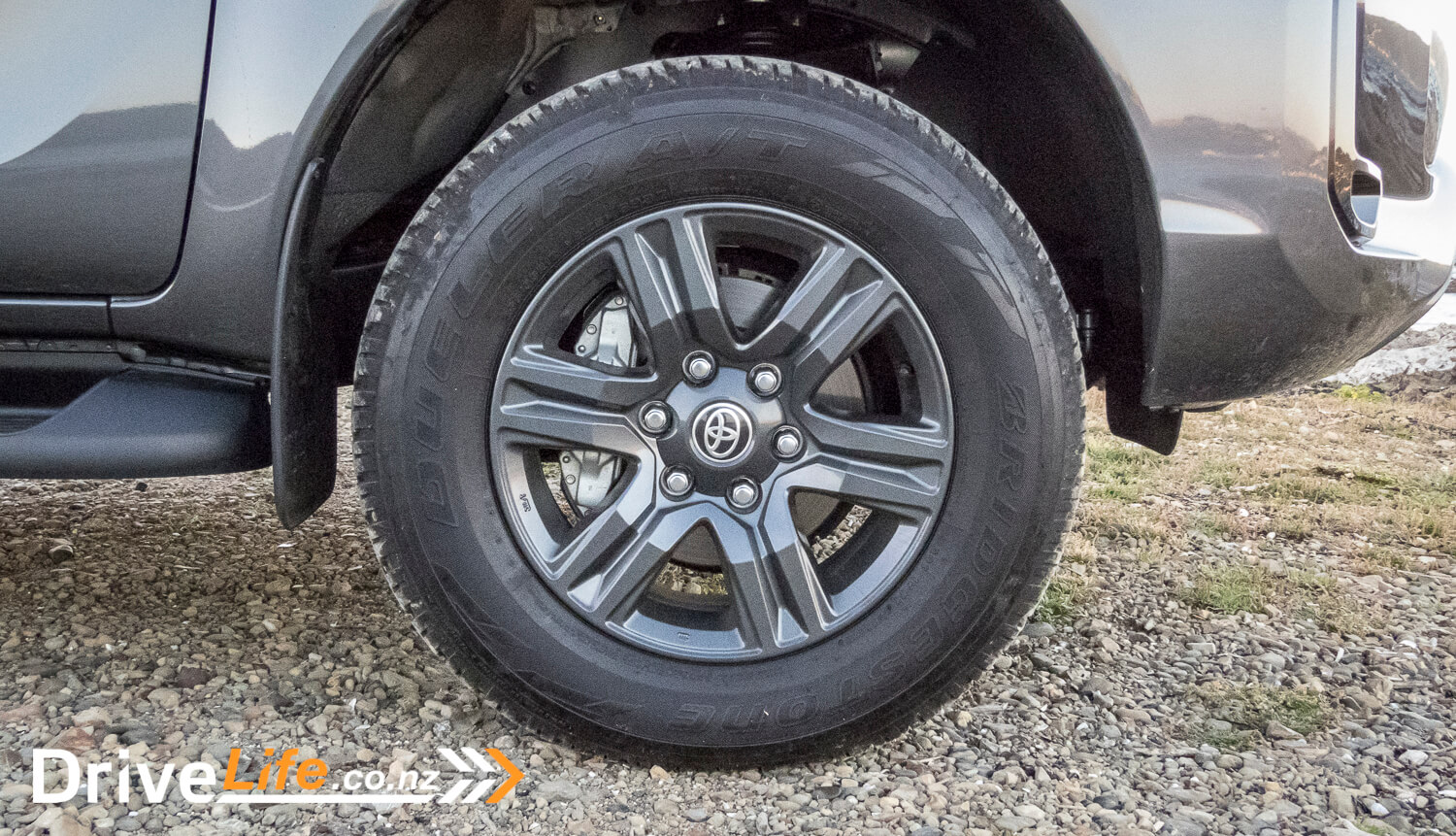
Adding to all the mechanical and driveline changes, Toyota has also made a series of tweaks to the suspension. Toyota is keen to point out the Hilux’s improved suspension set-up, which was a bone of contention with the previous generation Hilux.
Amongst the changes are re-tuned shocks and spring rates, new suspension bushes and cabin mounts, plus longer leaf springs at the rear. Double cabs also get an extra leaf at the back too.
Toyota has made all of these changes to make the Hilux friendlier on the road. If we’re being honest, this is where many utes will spend most of their time.
So, has it worked? Well, I would personally define the ride quality as liveable, but wouldn’t consider it segment leading. Ultimately, the Hilux is still a utility vehicle with a ladder frame chassis and rear leaf springs. The ride will be compromised as a result.
For example, an unladen rear tray is still a bit unsettled, but it goes with the territory. The improvements mean that you’re not going to feel inclined to throw a few bags of cement in the tray for added refinement.
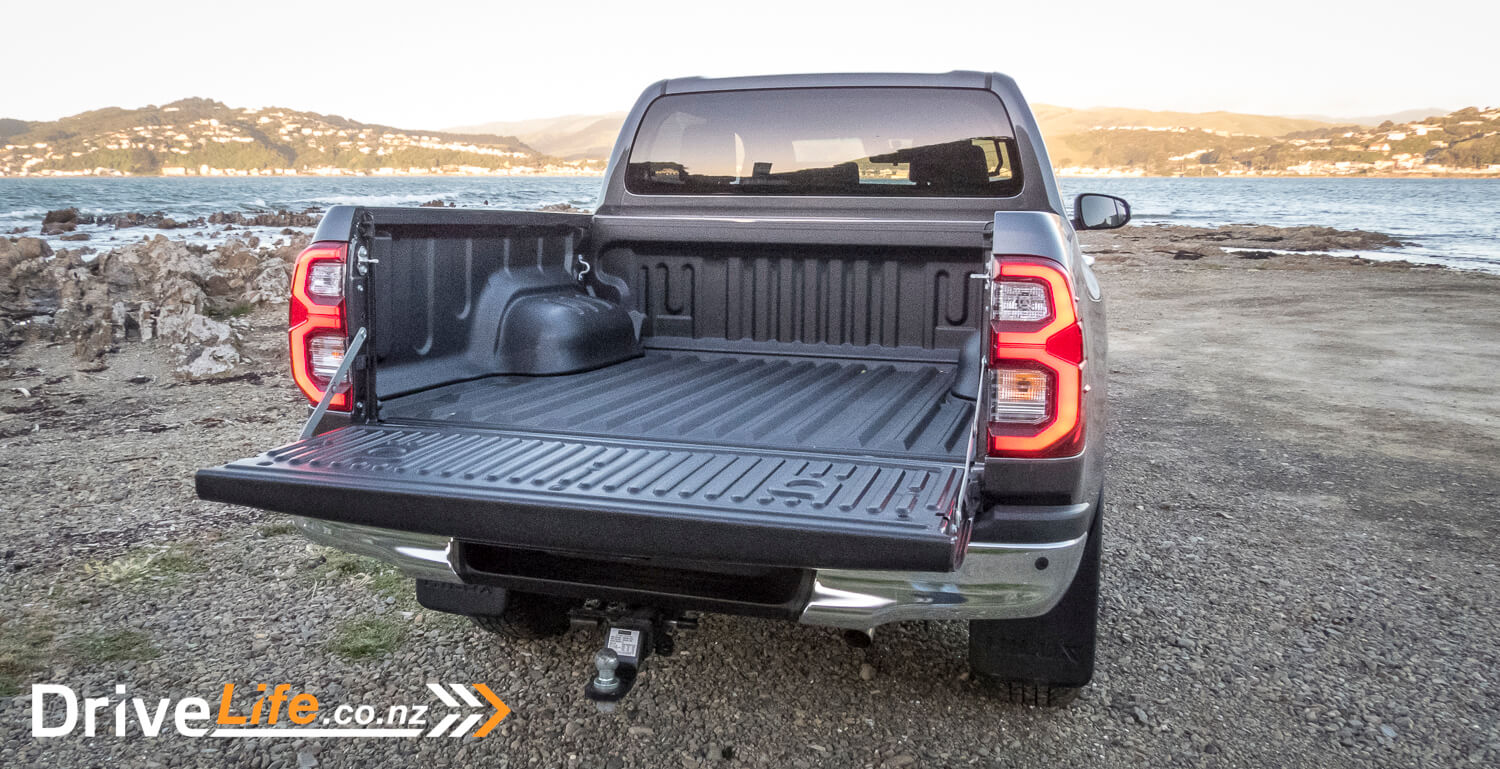
On the whole, I have few complaints with the ride quality. Toyota’s set it up quite nicely given the constraints. Yet, if you are considering using a Hilux for long distance hauling, you might be tempted to consider the higher-spec SR5 Cruiser. The Cruiser offers a quieter ride, plus a list of extra interior options to make the journey a bit more comfortable.
On the subject of cabin noise, I had few complaints with the level of noise inside the SR5. Although, it does noticeably improve with the SR5 Cruiser.
So far, all the discussion has been about the Hilux’s on-road performance. What about in its natural habitat, off-road? Sorry to disappoint, but our test of the SR5 remained on the tarmac. However, I experienced the Hilux range in an off-road setting during the launch event, and I can confirm, the Hilux indeed, performs.
The good news is that the off-roading recipe for the Hilux is largely the same. Many Hiluxes will be sold purely on their indestructible reputation and off-road capability, even if it never sees the mud.
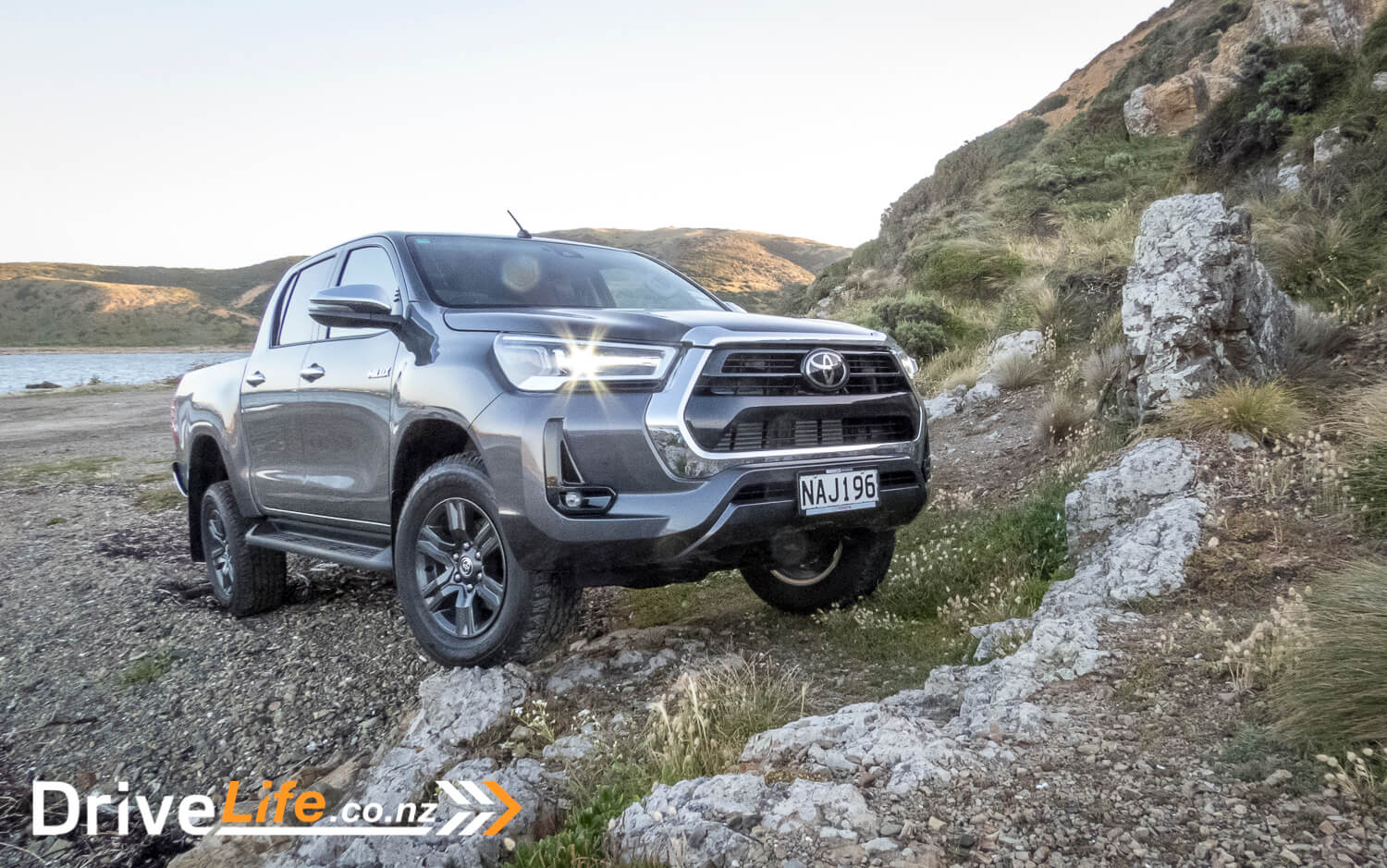
To help one avoid testing the limits of indestructibility, the Hilux range gets Toyota’s Safety Sense package, which has an array of modern safety gubbins. Although, it’s not a completely exhaustive list. You still miss out on blind-spot monitoring and rear cross traffic alert, despite our SR5 being one of the more expensive Hiluxes.
It’s a bit disappointing when the new $30,000 Toyota Yaris is more technologically gifted than the $50,000 Hilux (the Yaris gets both of the aforementioned).
However, the Hilux isn’t the only ute that misses out on these features. Plus, visibility from the Hilux is good, so you could argue that the extra features aren’t necessary.
The SR5 also has adaptive cruise control which operates down till 30kph, after which the driver has to take over. It all works as expected, though adaptive cruise works down to a halt is the ultimate chill-pill in heavy traffic. Given the option, I’d definitely pay more for it on any car. This is certainly an area Toyota could score some easy points.
Lastly, at the launch of the Hilux, I noted a slight fault with the traffic sign recognition. During our week with the SR5, the error did not crop-up again.
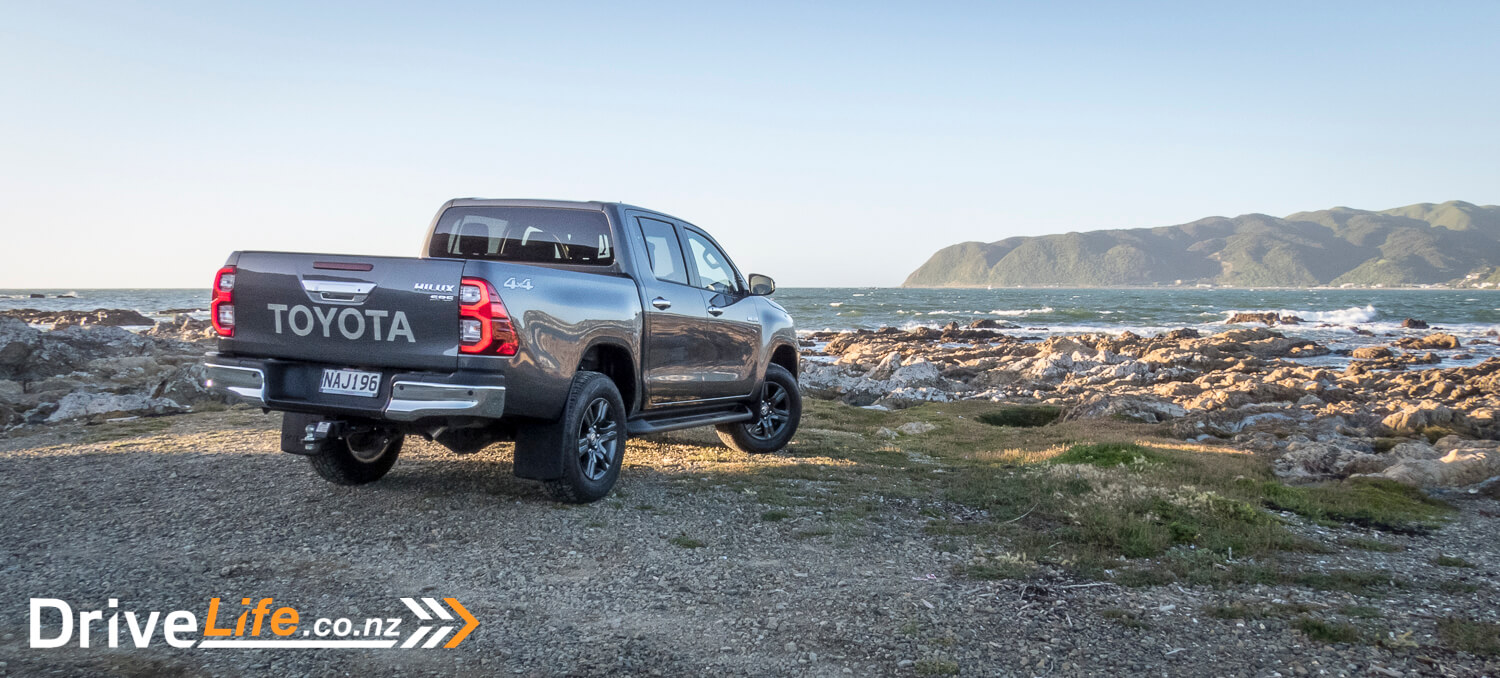
What’s The Competition For The 2021 Toyota Hilux SR5?
| Brand/Model | Engine | Power/Torque kW/Nm | Economy, L/100km | Tow Rating, Kg (Unbraked/Braked) | Price |
| Ford Ranger XLT | 3.2-litre 4-cylinder turbodiesel | 147/470 | 8.7 | 750/3500 | $64,990 |
| Volkswagen Amarok Comfortline | 2-litre 4-cylinder twin-turbo diesel | 132/420 | 8.5 | 750/3200 | $63,000 |
| Isuzu D-Max LSM | 3.0-litre 4-cylinder turbodiesel | 140/450 | 7.7 | 750/3500 | $61,990 |
| Mazda BT-50 GSX | 3.0-litre 4-cylinder turbodiesel | 140/450 | 8.0 | 750/3500 | $54,490 |
| Toyota Hilux SR5 | 2.8-litre 4-cylinder turbodiesel | 150/500 | 7.9 | 750/3500 | $53,990 |
| Nissan Navara ST | 2.3-litre 4-cylinder twin-turbo diesel | 140/450 | 7.0 | 750/3500 | $51,990 |
| Mitsubishi Triton VRX | 2.4-litre 4-cylinder turbodiesel | 135/437 | 8.6 | 750/3500 | $51,990 |
| GMW Cannon-L | 2.0-litre 4-cylinder turbodiesel | 120/400 | 9.4 | 750/3000 | $39,990 |
| SsangYong Rhino SPR | 2.2-litre 4-cylinder turbodiesel | 133/420 | 7.9 | 750/3500 | $38,990 |
| LDV T60 Luxury | 2.8-litre 4-cylinder turbodiesel | 110/360 | 9.6 | 750/3000 | $35,990 |
*All utes listed are double-cab variants.
What’s The Pros And Cons For The 2021 Toyota Hilux SR5?
Pros
- Excellent performance from revised turbodiesel engine
- Proven reliability and durability
- Improved ride over old model
- Off-road ability
- Sharp Pricing
Cons
- Few interior updates for new model
- Radar Cruise only works down till 30kph
- Short of the latest driver tech
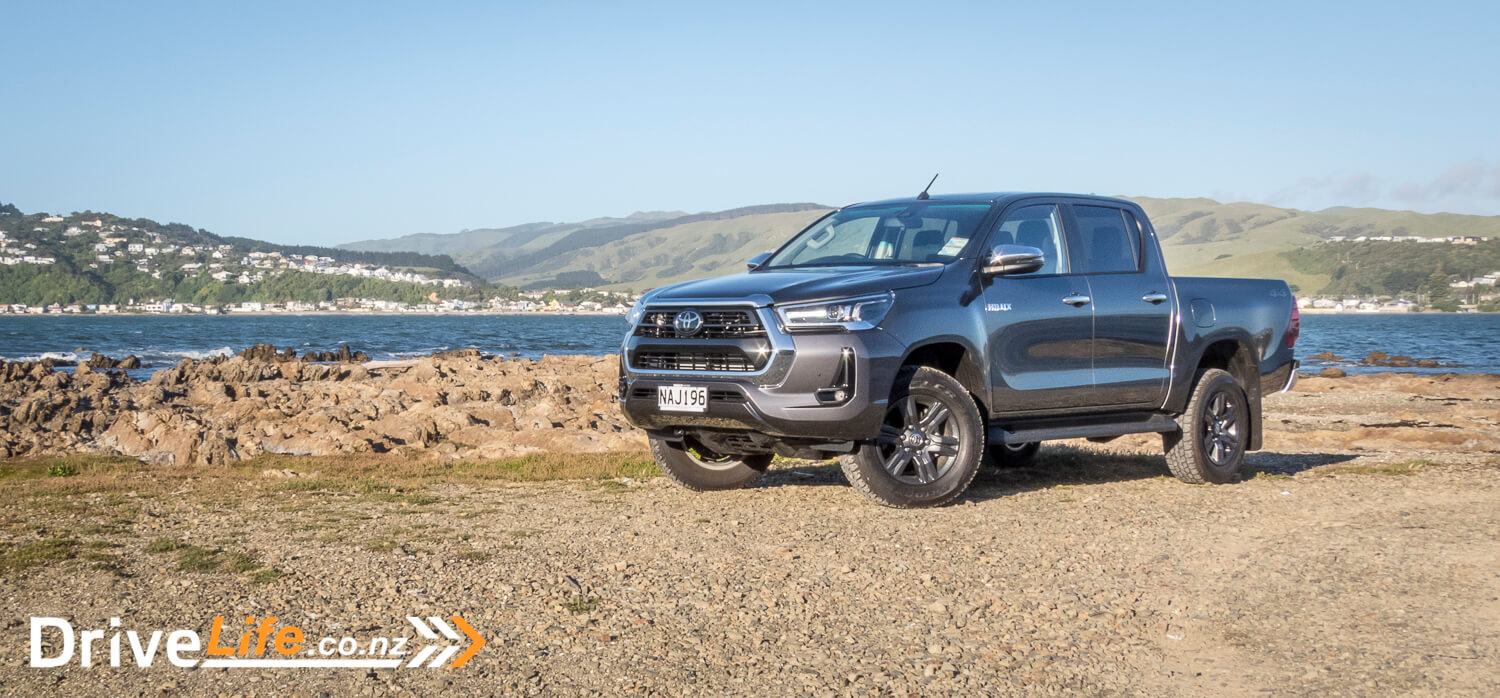
2021 Toyota Hilux SR5 – Specifications
| Vehicle Type | 5-door Double-cab Ute (4X4) |
| Starting Price | $44,990 |
| Price as Tested | $54,990 |
| Engine | 2.8-litre 4-cylinder turbo-diesel |
| Power, Torque (kW/Nm) | 150/500 |
| Transmission | 6-speed automatic |
| Spare Wheel | Full size (steel) |
| Kerb Weight, Kg | 2,100 |
| Length x Width x Height (mm) | 5325 x 1855 x 1815 |
| Fuel tank Capacity, litres | 80 |
| Fuel Economy L/100km (Combined) | Advertised Spec – 7.9 Real World Test – 10.4 Low Usage: 0-6 / Medium Usage 6-12 / High Usage 12+ |
| Towing Capacity Kg, unbraked/braked | 750/3500 |
| Tray Payload | 950kg (Other models up to 1225kg) |
| Maximum Wading Depth | 700mm (at 10km/h) |
| Approach Angle | 29o |
| Turning Circle, metres | 12.6 Small: 6-10m / Medium 10-12m / Large 12m+ |
| Safety Rating | 5 Star |
| Warranty | 3 years/100,000km warranty |


